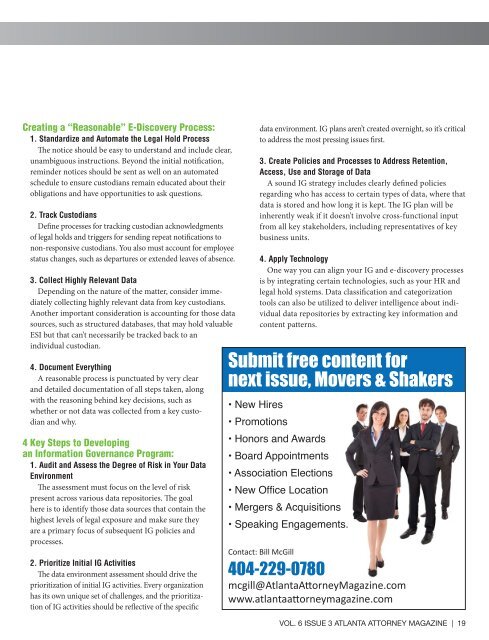AAL_05_17Web
You also want an ePaper? Increase the reach of your titles
YUMPU automatically turns print PDFs into web optimized ePapers that Google loves.
Creating a “Reasonable” E-Discovery Process:<br />
1. Standardize and Automate the Legal Hold Process<br />
The notice should be easy to understand and include clear,<br />
unambiguous instructions. Beyond the initial notification,<br />
reminder notices should be sent as well on an automated<br />
schedule to ensure custodians remain educated about their<br />
obligations and have opportunities to ask questions.<br />
2. Track Custodians<br />
Define processes for tracking custodian acknowledgments<br />
of legal holds and triggers for sending repeat notifications to<br />
non-responsive custodians. You also must account for employee<br />
status changes, such as departures or extended leaves of absence.<br />
3. Collect Highly Relevant Data<br />
Depending on the nature of the matter, consider immediately<br />
collecting highly relevant data from key custodians.<br />
Another important consideration is accounting for those data<br />
sources, such as structured databases, that may hold valuable<br />
ESI but that can’t necessarily be tracked back to an<br />
individual custodian.<br />
4. Document Everything<br />
A reasonable process is punctuated by very clear<br />
and detailed documentation of all steps taken, along<br />
with the reasoning behind key decisions, such as<br />
whether or not data was collected from a key custodian<br />
and why.<br />
4 Key Steps to Developing<br />
an Information Governance Program:<br />
1. Audit and Assess the Degree of Risk in Your Data<br />
Environment<br />
The assessment must focus on the level of risk<br />
present across various data repositories. The goal<br />
here is to identify those data sources that contain the<br />
highest levels of legal exposure and make sure they<br />
are a primary focus of subsequent IG policies and<br />
processes.<br />
2. Prioritize Initial IG Activities<br />
The data environment assessment should drive the<br />
prioritization of initial IG activities. Every organization<br />
has its own unique set of challenges, and the prioritization<br />
of IG activities should be reflective of the specific<br />
data environment. IG plans aren’t created overnight, so it’s critical<br />
to address the most pressing issues first.<br />
3. Create Policies and Processes to Address Retention,<br />
Access, Use and Storage of Data<br />
A sound IG strategy includes clearly defined policies<br />
regarding who has access to certain types of data, where that<br />
data is stored and how long it is kept. The IG plan will be<br />
inherently weak if it doesn’t involve cross-functional input<br />
from all key stakeholders, including representatives of key<br />
business units.<br />
4. Apply Technology<br />
One way you can align your IG and e-discovery processes<br />
is by integrating certain technologies, such as your HR and<br />
legal hold systems. Data classification and categorization<br />
tools can also be utilized to deliver intelligence about individual<br />
data repositories by extracting key information and<br />
content patterns.<br />
Submit free content for<br />
next issue, Movers & Shakers<br />
• New Hires<br />
• Promotions<br />
• Honors and Awards<br />
• Board Appointments<br />
• Association Elections<br />
• New Office Location<br />
• Mergers & Acquisitions<br />
• Speaking Engagements.<br />
Contact: Bill McGill<br />
404-229-0780<br />
mcgill@AtlantaAttorneyMagazine.com<br />
www.atlantaattorneymagazine.com<br />
VOL. 6 ISSUE 3 ATLANTA ATTORNEY MAGAZINE | 19










